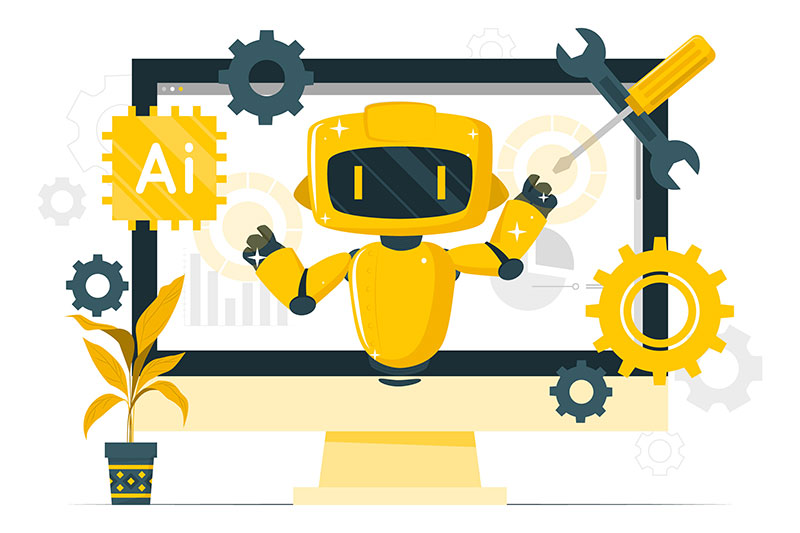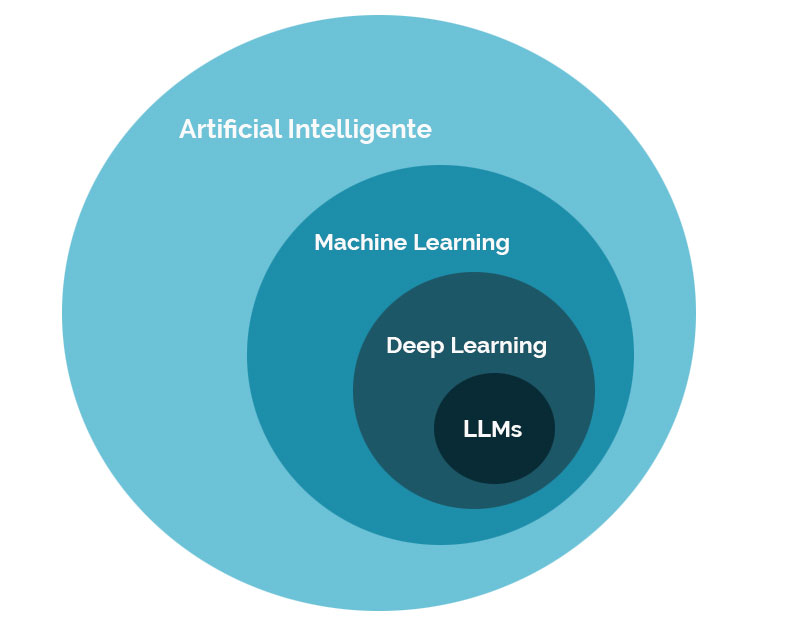Large Language Models: how do AI LLMs work and which are the best?
LLMs, or Large Language Models, are basically artificial intelligence supercomputers that understand and generate text in natural language, like ChatGPT, which has become very popular in the last year.
In this post, we will better understand how this technology works, its advantages and disadvantages, the main models on the market today and how they can be used in creating online courses.

What are Large Language Models (LLMs) and how do they work?
In simpler terms, an LLM is a computer program trained to recognize and interpret human language and other complex data types.
So you may be wondering, but how are these programs trained? Simple, they are “fed” with an immense amount of data collected from across the internet and beyond, with the aim of learning how to answer questions, create content, chat and much more.
LLMs use a type of machine learning called deep learning to understand how characters, words and sentences work together. To get a better understanding of how this all works within the world of AI, see the diagram below.

They are then trained and then go through an adjustment phase, which works as follows:
Training
- The model is trained with huge volumes of text (books, articles, web pages).
- It learns general language patterns such as grammar, logic, and even facts about the world.
- Common tasks include predicting the next word (causal language modeling) or filling in gaps (masked language modeling)
Adjustment
After training, the model is fine-tuned for focused tasks with more specific datasets.
This may include alignment with human preferences or application in specific areas, such as mathematics or customer service, for example.
To be fine-tuning is done through prompts (commands) for a specific task that the user wants the model to do, such as interpreting questions and generating answers or translating text from one language to another.
– 8 Best AI Tools for Writing Emails
Advantages and Limitations of LLMs
This technology is, without a doubt, extraordinary, bringing great ease and agility to the most diverse tasks.
However, one of its biggest challenges lies in the fact that the quality of the samples collected affects how well LLMs learn natural language, and the reliability of the data they generate.
This means that although they can perform many tasks, care must be taken when trusting the information generated.
LLMs can indeed provide incorrect or fictitious information, as they depend on the quality and diversity of the training data, and the internet is a sea of data of all types.
Another disadvantage is that, as you can imagine, these programs and require a lot of computation to train and operate, so it will still take time before more “perfect” answers are achieved, although there are already several models available online, such as the following, which we will explore in more depth throughout the article:
- GPT-4: One of the most advanced, widely used for general language assistance.
- PaLM 2: Excellent at multilingual and creative tasks.
- LLaMA: Focused on research and efficiency.
- Claude: Optimized for safe and ethical responses.
How to use LLMs?
As we mentioned, LLMs can be used in the most diverse tasks and areas of activity, facilitating and optimizing these activities.
Some possibilities include:
- Business and Customer Service: Response automation, intelligent chatbots, technical support.
- Education: Virtual tutors, personalized explanations, creation of teaching materials.
- Technology and Programming: Helps with code development, debugging and documentation.
- Health: Medical assistance, symptom analysis, organization of medical information.
- Academic Research: Summaries, bibliographic reviews, generation of hypotheses.
- Creativity and Content: Creative writing, idea generation, script development.
- Marketing: Campaign creation, trend analysis, message personalization.
– Tips for using AI in content marketing
How to Use LLMs in Online Courses
Although many people can only see LLMs as tools for generating text, they can go much further than that.
When creating online courses, you can bring more interactivity and personalization to learning.
Imagine a course where each student has an intelligent virtual assistant at their disposal, capable of answering questions, explaining concepts in different ways or adapting the content according to their individual pace and needs.
In courses with complex modules, such as programming or mathematics, the LLM can offer detailed or simplified explanations depending on the student’s previous experience.
It can also help in practice, correcting exercises and providing instant feedback, which reduces the need to wait for an instructor to return.
Furthermore, the model can suggest complementary materials, such as articles, videos or personalized exercises, to reinforce points where the student has difficulty.
Another application is in content creation. Instructors can use LLMs to generate study materials such as summaries, quizzes and multiple choice questions, saving time and ensuring content is up to date and relevant.
This is especially useful in courses that need to be updated frequently, such as technology, nutrition, or digital marketing.
Are you already impressed? Well, know that both your online course and your advertising can get even better!
LLMs can be integrated into course discussion forums or chats, functioning as moderators who answer frequently asked questions or help mediate discussions between students.
Finally, the models can be used in assessments, making automated corrections to tests (including essays) or giving feedback on written work, highlighting strengths and areas for improvement.
All of this contributes to a richer learning experience, accessible and adapted to each student.
To make everything clearer, let’s look at a practical example, which would be the use of LLMs in a language course.
– 8 Tips for creating successful online courses
How to use LLMs in an online language course?
With advanced text comprehension and generation capabilities, LLMs can be integrated to act as tutors, conversational partners, and creative assistants, meeting the needs of learners at different levels.
Imagine the model as a practice partner, available 24 hours a day.
It can simulate dialogues with students, adjusting vocabulary and sentence complexity based on each student’s proficiency level.
In addition to helping you practice writing and speaking, it has the ability to correct errors immediately, explaining the correction and even suggesting alternatives. This turns the practice into a continuous learning process.
In writing, LLMs are equally useful. They can grade essays or open-ended responses, providing detailed feedback on grammar, vocabulary, style, and coherence.
The student can also ask for help to expand their vocabulary, requesting synonyms, idiomatic expressions or examples of contextual use.
Another powerful application is in content personalization. LLM can create specific exercises for each student based on their difficulties, such as verb conjugation, translation or reading comprehension practices.
He can also generate quizzes, interactive games or challenges that keep students engaged and motivated.
Finally, LLM can be used to provide cultural context, explaining slang and expressions, or differences between regional variants of a language.
This helps the student not only learn the language, but also understand its practical and cultural use.
If integrated strategically, LLM can bring enormous benefits for both students and instructors.
– Best AI Tools to Create Online Courses
Top 5 LLMs on the market
We list 5 LLMs that are among the most used on the market today, each ideal for different types of applications.
1. GPT-4 (OpenAI)
The popular GPT-4 is one of the pioneering and most advanced LLMs available.
It is designed for understanding and generating text in a highly contextual and creative way, being widely used in virtual assistants, content creation, and business applications.
GPT-4 is integrated with popular tools such as ChatGPT and Microsoft Copilot.
Despite its power, it is a proprietary solution, which means that its implementation is restricted to licensed services.
– How to use ChatGPT to create online courses
2. PaLM 2 (Google)
PaLM 2 is the model underlying Google Bard and is known for its excellent performance in natural languages, translation and understanding of technical text.
It is designed for tasks that require logical reasoning and deep contextual analysis, making it very useful in fields such as programming and multilingual learning.
With its integration with Google products like Google Workspace, PaLM 2 is widely accessible to businesses and general users.
It also includes advanced support for technical contexts such as code interpretation and complex documents.
3. Claude (Anthropic)
Claude is a language model focused on security and ethical alignment.
It is designed to prevent unwanted behaviors such as toxic or harmful responses, making it a popular choice for companies concerned about ethics and reliability.
Claude combines text comprehension and generation abilities with strong moderation controls, making him ideal for sensitive tasks such as customer support or education.
Developers looking to integrate Claude into their platforms can access it via the Claude AI API, which provides robust tools for secure, aligned, and scalable LLM deployments.
Despite being less well-known than GPT-4 or PaLM 2, Claude is quickly gaining ground due to its focus on security and ease of use.
– 9 Ways to Improve Customer Experience in Online Teaching
4. LLaMA 2 (Meta)
LLaMA 2 is an open source model developed by Meta (formerly Facebook) and is recognized for its efficiency and adaptability.
It is designed to serve the developer community seeking full control over the customization and implementation of LLMs.
Because it is open-source, LLaMA 2 allows researchers and companies to train the model on their own data, ensuring privacy and specificity.
This makes it a flexible choice for companies that want a powerful model without reliance on proprietary services.
5. BLOOM (BigScience/Hugging Face)
BLOOM is an open-source, multilingual language model developed by the BigScience community and managed by Hugging Face.
It is designed to support a wide range of languages, including many that are less represented in commercial LLMs, such as African and indigenous languages.
BLOOM is widely used by researchers, educational institutions and organizations looking to promote linguistic and cultural inclusion.
While not as large as models like GPT-4, BLOOM stands out for its collaborative approach and focus on diversity.
– How to create accessible and inclusive online courses
Each of these models is designed with specific goals, and your choice depends on the needs of the application, such as privacy, accessibility, security or technical support.
Use LLMs to improve your online course and sell more

Although LLMs are still generating a lot of debate, mainly because they are considered a threat to many professions, one thing is undeniable: they are here to stay.
When it comes to innovations and technological advances, it is almost impossible to stop, so it is more coherent to think about how to make use of these new tools to deliver an even better service to your end customer.
In the case of online courses, there are several ways to use LLMs to create more complete and better content and courses, offering an excellent learning experience to your students.
As with all new features, we suggest that you start by testing and trying to implement one or two of the features mentioned, until you become more familiar with using these models and can move forward.
As easy as it has become to access information on the internet, the machine is still not capable of replacing a good teacher.
Complete eLearning platform, Coursify.me is the ideal solution for anyone who wants to create, sell and promote courses on the Internet.
Serving companies and professionals in more than 60 countries, Coursify.me is a dynamic, intuitive and customizable LMS.
– Whats is a Learning Management System
To learn more, visit our website, test the platform and see why we are the best option for your online courses.

